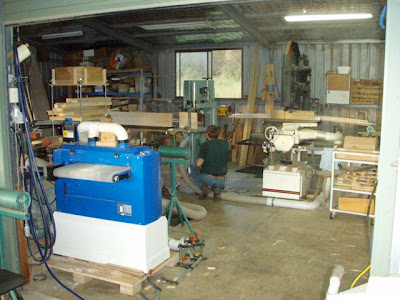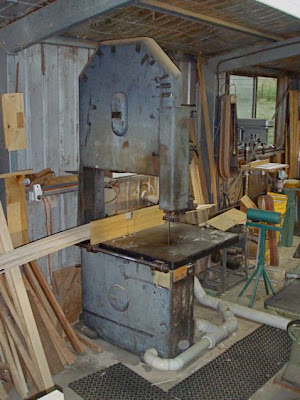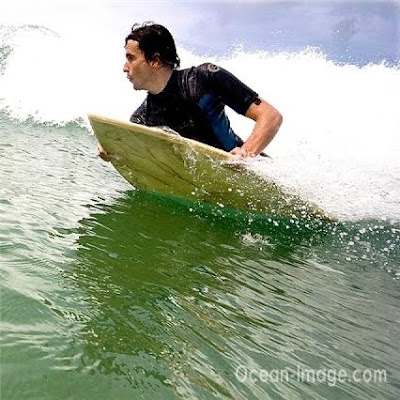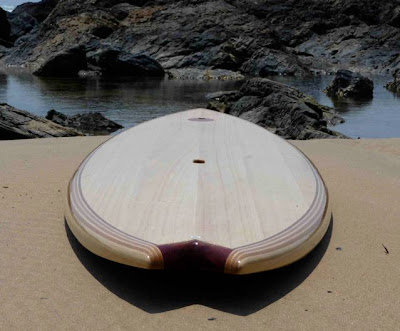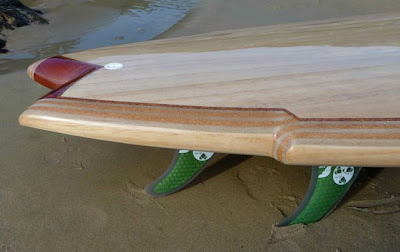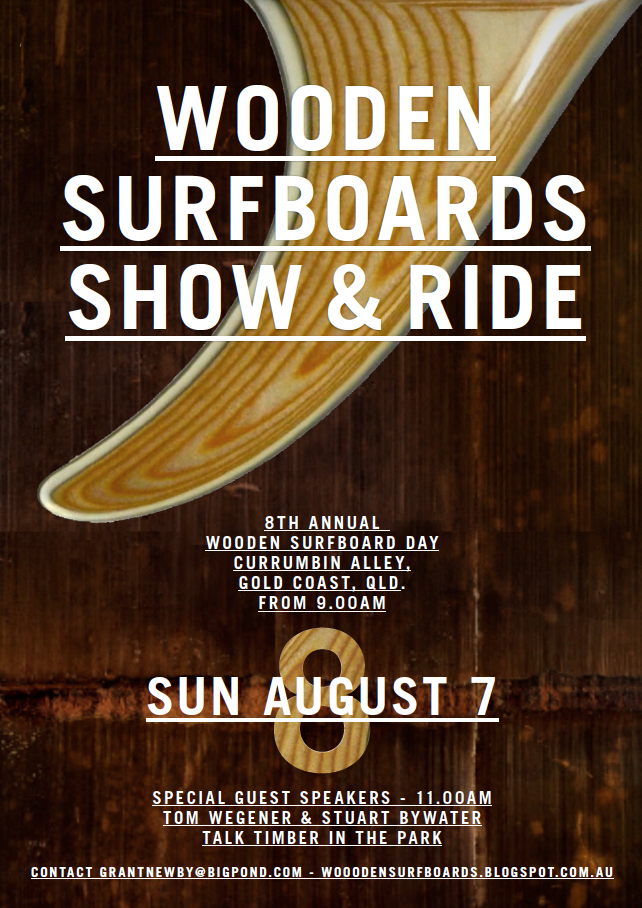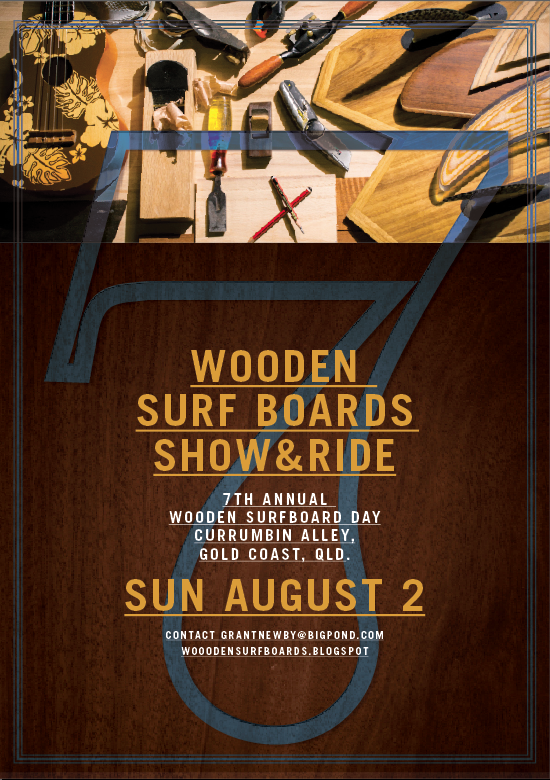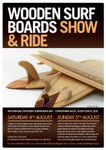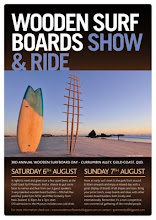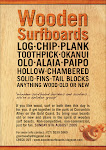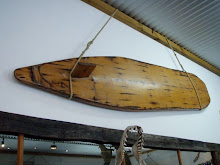
Mike Tuten , Hawaiian shaper
His workshop consists of two rooms, tucked away in Waialua’s Old Sugar Mill. This is where surfboard shaper Mike Tuten works. He’s standing under the strained whirring of a ventilation fan clogged with foam dust, which covers everything including the radio, presently pumping out Greatest Hits: The Police at top volume.
Tuten is 44, big and blond with the intense blue eyes and demeanor of the Teutonic German warriors from whom his name and lineage derive. His electric planer whines to a stop and he extends one of his big hands. These are the kind of hands only found attached to craftsmen and artists. Tuten is a bit of both.
Tuten has been a fixture of the North Shore shaping community for decades. Twenty-nine years ago, he shaped his first board out of balsa wood, which is light, strong and easy to manipulate. That board was followed by another and another and another.
“Mike is making more balsa boards than anyone in Hawaii with possibly one exception,” says Andre “Chispa” DeLaTorre, the main balsa supplier to Hawaii. As years passed, Tuten plied his craft for some of the biggest surf companies, progressive pros (Tom Curren and Jordy Smith to name-drop two) and, eventually, wealthy private collectors. Along the way, he formed about 18,000 surfboards out of the chunks of foam and wood that are his primary media, and amassed a dedicated and burgeoning client list.
As Tuten’s skills and client list grew, he began experimenting with more exotic lumber: Koa, redwood, African mahogany, curly makore and waterfall bubinga. He also expanded his approach to design, and began shaping olo and alaia boards. But his newest project is by far the most interesting.
“You ever see a piece of wood like this before?” he asks, motioning behind him to a dark plank of wood leaning in the corner of his shaping bay. The wood is dark and chunky but velvety to the touch. It looks a bit like the top of a grand piano for a cavemen.
Last year, Tuten bought several lengths of wood cut from an ancient kauri tree. Kauri are one of the largest trees in the world, can live for 2,000 years, grow to 200 feet and achieve a girth of 40 feet. With protected status, it’s now illegal to cut them down. The only source of kauri wood available today is ancient logs buried underground on the North Island of New Zealand, considered to be the world’s oldest workable timber. The raw boards Tuten has purchased are from a tree that splashed down into a peat swamp–legend says the tree fell when a tsunami flattened the island–where it lay encased in a cocoon of mud that prevented petrifaction and rotting until it was found and unearthed in perfect condition.
Similar in density to cherry and in texture to basswood, ancient kauri’s swirling grain pattern–called “curling”–shimmers in holographic tones of gold and cognac. There are eight known pieces of this grain pattern in the world and Tuten has three.
Tuten stumbled across the Kauri while working for a client who wanted something really special. After the client rejected a piece of $10,000 African cherry as not special enough, Tuten started to dig. Through conversations with local “wood guys” and hours of Internet research, he found kauri wood, which is sold though a single distributor in Los Angeles.
Not only are they rare and beautiful pieces of wood, but they are old. Really, really old. About 45,920 years old, and with carbon dating tests to prove it. Tuten is making surfboards from wood that was around at a time when Cro-Magnons walked the Earth. This wood predates the creation of the Great Lakes by 30,000 years, the concept of farming by about the same, and could have provided shade for wooly mammoths and saber-toothed tigers–if those creatures had lived in Aotearoa, of course.
“Everything about these boards is special,” says Tuten. “When you sand into the board, the ancient sap is released and will just hang in the air like a mist that smells like butterscotch and genesis.”
Tuten took the wood into his bay and hand-milled it into a seven-foot alaia, a traditional Hawaiian design that is in the midst of a modern resurgence. Tuten has made many of the alaias that are being ridden on the North Shore today.
Ancient Hawaiians made their boards out of local woods–‘ulu, koa and wiliwili–in four different sizes. The largest of the ancient surfboards, the 18-to-25-foot olo, was reserved for alii (royalty). Any commoner who rode an olo did so under penalty of death and drowning–perhaps proof that the hierarchy in the modern line-up (and the tendency for surfers to enforce it through violence) is not a contemporary social construct.
So far, Tuten has shaped two boards out of his kauri wood in the alaia style, and has enough wood left to do several more–but they aren’t cheap. The first of Tuten’s boards went for $38,000 to the private collector who commissioned it, while the other is on display at Island X Hawaii, a retail space at the sugar mill that sells locally made clothing and other products. Tuten has plans for more, and says he is always looking for new materials, designs and projects.
“I am trying to create boards that are really special, whether that means they are going into giant Sunset, knee-high New England, or a display case on a wall,” he says. “These kauri boards are truly unique, but a board doesn’t need to cost a million dollars to be special. As a shaper, it is my job to create a million-dollar board for everyone who walks through my door.”
Article from Honalulu Advertiser
I grew up in Northland , New Zealand in Dargaville a town that grew out of the Kauri forests and sawmills. Kauri is a beautiful timber and is not easy to get hold of these days. This swamp Kauri is hard to get mainly as it is buried in the lush farmland of the North. And a farmer isn't that keen to have you dig up his pasture to uncover it. Some of the logs are huge as the trees were massive. Being buried in mud and dirt of peat swamps for so long has preserved them well and the bulk of the timber is still very useable. And yes it is old forest timber at 30 - 40,000 years old.Tane Mahuta, "Lord of the Forest" is a still growing Kauri tree in the Waipoua Forest just North of where I grew up and is some 1,200 years old and 52m tall.My early settler family relatives were timber cutters , mill owners and boat captains all involved in the Kauri timber trade of early New Zealand on the Northern Wairoa River.
 The beauty of the right gear sure makes the job and the possibilities easier. Here Mike uses his resaw bandsaw to take off slices to become deck and bottom skins.
The beauty of the right gear sure makes the job and the possibilities easier. Here Mike uses his resaw bandsaw to take off slices to become deck and bottom skins. Mike is gluing up planks to be deck skins and I am adding a foam block to the nose to add surface area to glue to.
Mike is gluing up planks to be deck skins and I am adding a foam block to the nose to add surface area to glue to. Polyurethane glue is the best thing invented. It goes off with moisture and dries fast. The glue ends up the same colour as the wood and because it foams up it goes into all spaces if there are any. Great stuff , so look for Fix It Mate or Pur Bond as they are water proof.
Polyurethane glue is the best thing invented. It goes off with moisture and dries fast. The glue ends up the same colour as the wood and because it foams up it goes into all spaces if there are any. Great stuff , so look for Fix It Mate or Pur Bond as they are water proof. Frame all glued up with blocks glued in for fin box and second rail band on.
Frame all glued up with blocks glued in for fin box and second rail band on. Small blocks back from the nose is to take the gore tex breather.
Small blocks back from the nose is to take the gore tex breather. Fish all glued up , don't forget to have holes linking all spaces and those spaces with the top and bottom on become air spaces and they all need to breath .
Fish all glued up , don't forget to have holes linking all spaces and those spaces with the top and bottom on become air spaces and they all need to breath .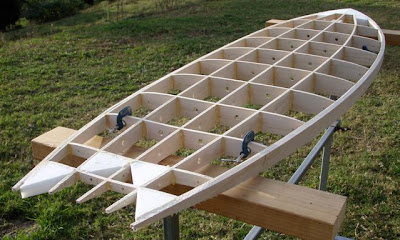 Tail section foam is to add support in the finer areas once the V for the fish tail is cut in.Second 6mm rail band is on as well and this really starts to stiffen things up.
Tail section foam is to add support in the finer areas once the V for the fish tail is cut in.Second 6mm rail band is on as well and this really starts to stiffen things up.

